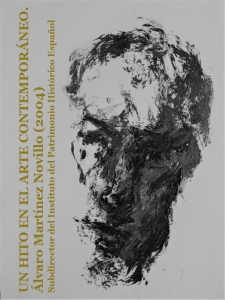A milestone in Contemporary Art. Álvaro Martínez Novillo (2004)
Text included in the book “El hacedor de sueños”, published on the occasion of the exhibitions in homage to Enrique Gran.
Caja Cantabria Cultural Centre, Santander, 2005. Caja Cantabria Palace, Santillana del Mar, Cantabria, 2005. Lebaniego Study Centre (Church of San Vicente), Potes, Cantabria, 2005.
A MILESTONE IN CONTEMPORARY ART
Text extracted from the book “El hacedor de sueños”, published on the occasion of the exhibitions in homage to Enrique Gran. Caja Cantabria Cultural Centre, Santander. 2005 Caja Cantabria Palace, Santillana del Mar, Cantabria, 2005 Centro de Estudios Lebaniegos (San Vicente Church), Potes, Cantabria, 2005.
I have found the notes of a conversation I had with Enrique Gran in the spring of 1991 and, on re-reading them, I have rediscovered his unique personality. He always seemed to me to be a quiet person who, however, when he broke up with his words, he did so with words full of passion.
He said that art had been for him “an irrepressible vocation”, while he told me how, since he was a child, he drew everywhere, both on the kitchen table and on the road with a chalk, to such an extent that the director of the school he attended recommended that his family enroll him in Arts and Crafts.
He told me this in his studio, while showing me his work, so strongly telluric, and that space was filled with the intensity of his paintings and his explanations. In front of one I wrote that he said: “Since you are in the world, you are scratching to be you”. He arrived in Madrid with the illusion of being a comic book artist, because he was fascinated by comics and cartoons. The three gentlemen of Walt Disney, with their mixture of images, a real collage in delirious movement due to its colour and rhythm, became an obsession for him, coming from a rural environment dominated by the sea and the mountains, to such an extent that he recognised that he was going to see it for a fortnight in a row.
But destiny traced another path for him when he was taken to the San Fernando School, where he was lucky enough to find some young people who were willing to throw themselves into life without inhibitions or aesthetic restrictions; thus, some opted for abstraction and others for figuration, following exclusively their own inclination and willing to defend their freedom with their lives. From very early on Enrique followed the first option and thus stated that he preferred the path “of tacticism, of total rupture”.
But within Informalism the possibilities are immense, and Gran always opted for a plastic art in which matter has a singular specific weight. His is not a “precious” art in which colour and subtleties have the leading role, but it undoubtedly belongs to the organic, living and dense forms that float in space like a kind of animated meteorite. Explaining his process in front of one of his paintings, Enrique told me: “You enter into the error. so that from the error an order emerges”. And I think this is a very accurate opinion about his creative process.
He added that he painted big because it forced him to “play” and said that he intended to compose coldly, “as if with detachment”. I have my doubts about the latter, because I think that never in his life has Enrique started to paint without getting passionately involved. In any case, his would be an autonomous passion, but the fire would always burn inside him. And this is not just a figure of speech.
I remember that at that time he showed me a landscape called Piedraluenga, of large dimensions (113 x 193 cm), which left me particularly moved. The strength of the composition was tremendous; its brushstroke, strong and superb; its colour, truly masterful. Before such a resounding and definitive painting, painted to be in a museum, I truly understood the greatness of its author, because a work like this is conceived with his back to the opinion of others, it arises from within its creator as a necessity of his, without thinking about who will be able to buy it or what the critics will say about it. Nor does it matter if it is stylised or not. Works like this, and Enrique Gran has many, especially in his last period, mark, in my opinion, a milestone in the art of the era in which we live. Since I saw this unique landscape, I have not been able to forget it and it is part of the cultural heritage of the era in which I have lived. And for that I will always be grateful.
Álvaro Martínez-Novillo. Deputy Director of the Spanish Historical Heritage Institute
Madrid, 27 December 2004
